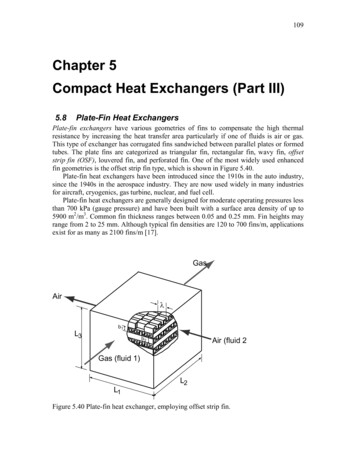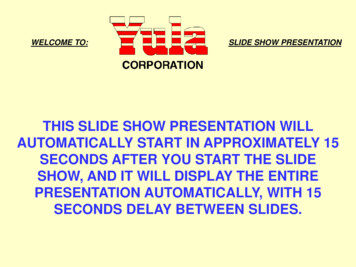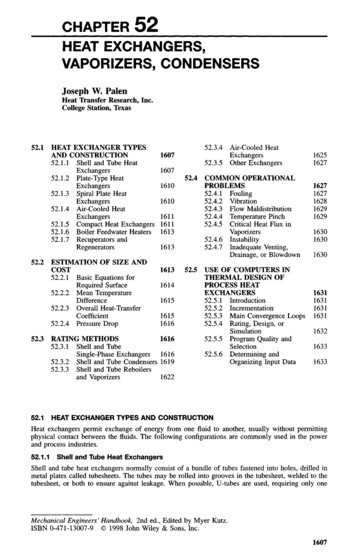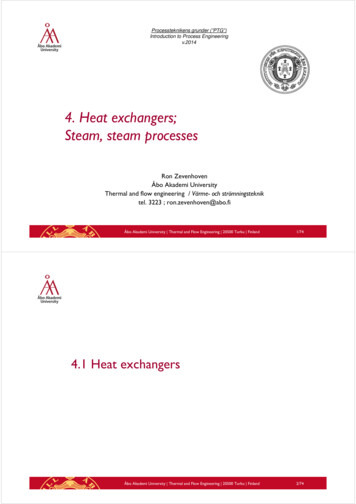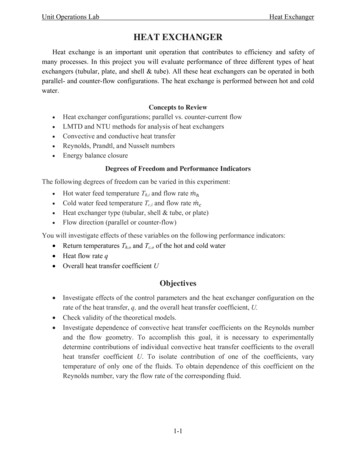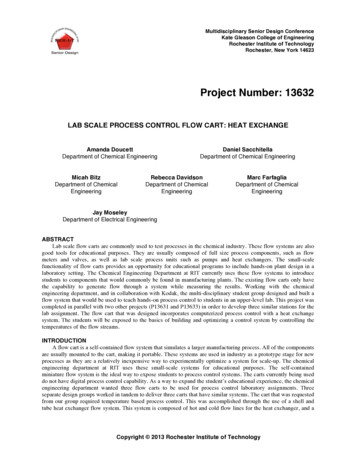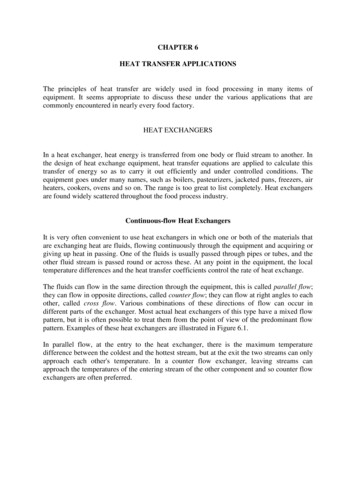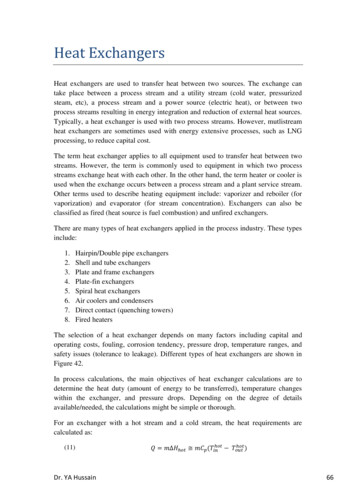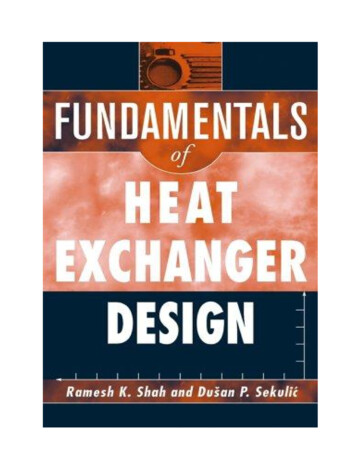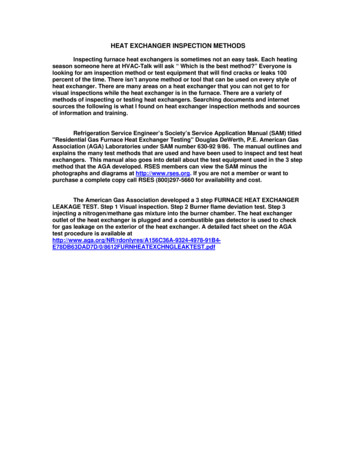
Transcription
Applications – Power train – Heat exchangersTable of contents7 Heat exchangers . 27.1 General aspects. 27.1.1 Brief history. 37.1.2 Applications of heat exchangers. 37.1.3 Advantages of aluminium in the design of heat exchangers . 37.2 Design and manufacturing of aluminium heat exchangers. 47.2.1 Mechanically assembled heat exchangers . 67.2.2 Brazed aluminium heat exchangers . 77.3 Material requirements and functions . 87.3.1 Fin material. 97.3.2 Bare and clad rolled materials for headers, plates, longitudinally welded tubes, etc. . 107.4 Applications . 147.4.1 Engine cooling system (radiators) . 147.4.2 Oil coolers . 197.4.3 Heater cores . 237.4.4 Air conditioning . 257.4.5 Charge air coolers. 347.4.6 Diesel fuel cooling. 397.4.7 Exhaust gas heat exchangers. 417.4.8 Parking heaters. 427.4.9 Cooling modules . 437.5 Future perspectives . 44Version 2011 European Aluminium Association (auto@eaa.be)1
7 Heat exchangers7.1 General aspectsToday’s heat exchangers must meet a variety of highly demanding requirements. In terms ofperformance, they have to ensure maximum heat transfer while keeping size to a minimum.Furthermore, the durability of heat exchangers must be extremely high, providing trouble-freeperformance throughout its service life at low manufacturing costs. Aluminium, in its variousforms, offers clear possibilities to achieve these goals and is also well positioned to meet thechallenges of the increasing market demands for cost effective, energy-efficient products andnew customized, innovative applications. This is made possible by the large variety ofaluminium-based materials and product forms that empower system designers andmanufacturers with multiple options for significant design improvement and cost reduction.Oil coolerSource: Behr GmbH & Co. KGVersion 2011 European Aluminium Association (auto@eaa.be)2
7.1.1 Brief history As early as 1950, aluminium heat exchangers made moderate inroad into theautomotive industry. With the introduction of the vacuum brazing technique, large scale production ofaluminium-based heat exchangers began to flourish. Significant growth in the use of aluminium heat exchangers resulted from advantages ofthe controlled atmosphere brazing process (Nocolok brazing process introduced byALCAN). Introduction of “long life” (highly corrosion resistant) alloys further improvedperformance of aluminium heat exchangers. Additional demands for aluminium heat exchangers resulted primarily from the growthof automobile air-conditioning systems and new applications due to the increasingengine performance.7.1.2 Applications of heat exchangersAluminium heat exchangers are used in one of the following main application categories: Engine cooling (radiators) Oil cooling (oil of the engine main lubrication circuit, the manual and automatictransmission, the power steering, etc.) Condensers and evaporators for air-conditioning systems Heaters Charge air, exhaust gas and fuel cooling.In each application, the heat exchanger must fulfil specific performance requirements asking fordifferent design and manufacturing concepts as well as material characteristics. On the otherhand, due to intensifying demands on compactness combined with light weight, heatexchangers are increasingly being produced as modules. The combination of up to four heatexchangers in a vehicle’s front structure is currently state-of-the-art, significantly reducing theoverall volume, weight and cost of the total cooling system.7.1.3 Advantages of aluminium in the design of heat exchangersThe business case for aluminium heat exchangers is based on two components, the costsavings realized by substituting an expensive raw material, copper, with a less expensive rawmaterial, aluminium, and, the cost savings that are made possible by implementing higherperformance products and more efficient fabrication processes. Aluminium offers a number ofadvantageous material characteristics for heat exchangers: Significant potential for lightweight designHighly automated, reliable manufacturing process (brazing)High thermal conductivity, also when joined by brazingExcellent corrosion resistanceGood formabilityAdequate strength to resist temperature and pressure cyclesEasy recyclability, i.e. an environmentally friendly solutionCommercial availability of a wide range of aluminium alloys and product forms to meetdifferent design options.Version 2011 European Aluminium Association (auto@eaa.be)3
7.2 Design and manufacturing of aluminium heat exchangersAlthough a wide variety of design concepts for aluminium heat exchangers exist, they invariablyfall into one of the following categories: Tube / fin Plate-fin Plate-bar Extrusion / fin.The majority of the heat exchangers used in today’s automobiles are based on tube / findesigns. In special applications, however, conceptual designs based on other aluminiumproduct forms may well show clear advantages.Charge air cooler in a tube / fin designSource: Behr GmbH & Co. KGThere are three types of tubes for heat exchanger applications: Welded tubes Folded tubes Extruded tubes, and these can be round tubes (RT) or multiport extrusions (MPE).Round extruded tubes can be subjected to a drawing operation for further reduction of the wallthickness and a closer control of the geometrical tolerances. MPE tubes are flat tubes withmultiple small channels running the length of the tube, i.e. they could be described as one largetube split into multiple smaller parallel ports. The flat geometry of MPE tubes results in reducedaerodynamic drag and an advantageous development of the heat transfer boundary layerleading to larger heat transfer coefficients on the air-side. The enhanced heat transfer of MPEtubes results from the increased ratio of the heat transfer area to the internal volume, and afavourable impact on the coolant flow regime and the dominant heat transfer mechanism.Two distinct assembly techniques are used for the manufacturing of tube / fin aluminium heatexchangers: Mechanical assembly and Brazing.The fabrication of these two types of heat exchangers requires different processes, equipmentand often different alloys. The primary advantage of mechanically assembled heat exchangerscompared to brazed heat exchangers is the lower investment cost. But brazed heat exchangersVersion 2011 European Aluminium Association (auto@eaa.be)4
have a better thermal performance rating in comparison to mechanically assembled ones.Consequently, brazing is today the dominating assembly method for aluminium heatexchangers. In specific cases, also other joining technologies can be applied in the productionof heat exchanger components, e.g. adhesive bonding or mechanical joining methods such asclinching, self-piercing riveting, etc.The preferred design and manufacturing approach for aluminium evaporators and condensersis to combine the use of multiport extrusions with the brazing process. The considerablyimproved performance of these heat exchangers offers the potential for a substantial reductionin system cost through reduction of weight and size, reduced fan power requirements,increased durability, etc. Heat exchangers for single-phase liquid coolants or oils are preferablydesigned using round tubes as the application of multiport extrusions results in a too highpressure drop.Welded round tubes can be used in mechanically assembled heat exchangers as liquidlines or as header pipes, e.g. in brazed condensersSource: SapaExample of a tube design combining longitudinal seam welding and folding which isnormally used in e.g. heaters and radiatorsSource: SapaVersion 2011 European Aluminium Association (auto@eaa.be)5
7.2.1 Mechanically assembled heat exchangersA mechanically assembled heat exchanger of the round tube plate fin (RTPF) design typicallyconsists of extruded and sometimes drawn aluminium alloy tubes and fins stamped from rolledaluminium material. The inner surface of the tubes may be smooth or may have an enhancedsurface. The enhancements can have a variety of geometrical shapes. Likewise, a great deal ofeffort has gone into improving air-side heat transfer using plate fins in a variety of geometriesand degrees of complexity, e.g. the use of interrupted surfaces to reduce the resistance in theboundary layer.The two components are assembled by inserting (“lacing”) the tubes into the formed fin collars.At this point, the tube outer diameter is slightly undersize with respect to the fin collars, makingthe lacing process easy. The next step is to expand the tube diameter by inserting a mandreland rod assembly into the tube that is larger than the tube’s inner diameter. The result is amechanical “joint” between tube and fin that provides the conduction path for heat transfer fromthe refrigerant to the tube wall, to the fin and finally to the air.Mechanically expanded RTPF heat exchangers have some inherent weaknesses. Although themechanical bond between tube and fin provides good contact, there is still a significant amountof contact resistance that reduces the effective heat conductivity. This contact resistance is maybe due to oxides and/or other contaminants present in the interface between the outer tubesurface and the fin collar, but also any geometrical irregularity which results in a less thanperfect contact during the tube expansion process. The contact resistance will generallyincrease during service, further deteriorating heat transfer performance over time. The primaryproblem is that corrosion will result in the growth of oxides and other corrosion products that actas insulators at the fin/tube interface.Mechanically assembled aluminium radiatorSource: Behr GmbH & Co., KGVersion 2011 European Aluminium Association (auto@eaa.be)6
7.2.2 Brazed aluminium heat exchangersBrazed aluminium heat exchangers show a metallurgical bond between tube and fin which hasa positive impact on several performance measures. Most important is the elimination of thecontact resistance between tube and fin leading to significantly improved heat conduction.Different brazing processes have been used commercially to manufacture aluminium heatexchangers: Controlled atmosphere brazing Vacuum brazing Salt bath brazing Neitz process Ni brazing.However, aluminium heat exchangers for automotive applications are today generally producedby controlled atmosphere brazing (dominating method) and vacuum brazing. Ni brazing ofautomotive heat exchangers is executed today only by one major company. Salt bath brazing isstill used, but only for small volume production.The manufacturing of brazed heat exchangers using tube and fin components is wellestablished within the automotive heat exchanger industry. Highly-automated assembly andbrazing processes suitable for high volume production provide both high throughput andexcellent quality leading to heat exchangers comprised of joints made with 100% metallurgicalbonding.Aluminium producers, brazing flux producers and furnace builders actively work together toimprove and further develop the brazing processes for better economy and environmentalfriendliness. A wide range of heat-treatable and non heat-treatable aluminium alloys areavailable both for tubes and fins. Suitable aluminium materials for brazing applications (coils,sheets and tubes) can be delivered in a large variety of alloy combinations, clad ratios, sheetthicknesses and widths according to customer specifications.Brazed oil coolerSource: NovelisVersion 2011 European Aluminium Association (auto@eaa.be)7
7.3 Material requirements and functionsAluminium alloys are now well established materials for the manufacture of automotive heatexchangers. They offer properties that can be favourably utilised in various components: High thermal conductivity Low density Adequate strength (also at elevated temperatures) Good formability Excellent corrosion resistance.Proper selection of aluminium alloys and product forms offers the possibility to develop andproduce the various types of heat exchangers used in modern automobiles and to respond tothe ever increasing market demands with respect to improved heat transfer performance, butalso reduction of weight, size and cost.For heat exchangers, different types of rolled as well as extruded aluminium products are used: Flat rolled materials, e.g.: Unclad fin stock for radiators, charge air coolers, heaters, etc. Clad fin stock for condensers Clad header plates and side plates for various types of heat exchangers Clad strip for welded or folded tubes for radiators, charge air cooler, heaters, etc. Clad plates for evaporators and oil coolers. Extruded material, e.g.: Extruded tubes for evaporators, radiators, condensers, etc. Extruded and drawn tubes for radiators, heater cores, evaporators and condensers Multiport extrusion tubes (MPE) for evaporators, condensers, charge air coolers,etc. Extruded shapes.The specific characteristics of aluminium heat exchanger materials differ depending on theproduct form and the envisaged application. Consequently, several aluminium alloy systems areused in heat exchangers and there are numerous alloy variants which have been developed foroptimum performance during assembly (in particular depending on the applied brazing method:vacuum brazing or controlled atmosphere brazing utilizing potassium aluminofluorate fluxes)and in service (i.e. excellent corrosion resistance).Non heat treatable (NHT) and heat treatable (HT) aluminium alloys can be selected for thedifferent heat exchanger components. In pure aluminium and NHT alloys, strain hardening bycold deformation increases the basic strength achieved through solid solution and dispersionhardening. Recovery and recrystallization processes during brazing, however, will eliminate anystrength increase by strain hardening. HT alloys are strengthened by cold deformation as well,but offer in addition the possibility of precipitation hardening. Brazing processes carried out atapprox. 600 C are ideal to dissolve the soluble alloying elements. Subsequent fast cooling willretain these elements in supersaturated solution. Precipitation hardening, i.e. the nucleation andgrowth of fine precipitates in HT alloys can then lead to a significant strength increase, both atroom temperature (natural hardening) or by ageing in the temperature range 150-200 C eitherin a separate heat treatment step or – immediately after brazing - by controlled fast cooling andholding of the brazed component in the critical temperature range for a certain time.Version 2011 European Aluminium Association (auto@eaa.be)8
7.3.1 Fin materialFins require a high thermal conductivity, an advantageous strength-to-weight ratio and goodcorrosion resistance. Most important is also the ability of aluminium alloys to be formed intocomplex fin geometries. In mechanically joined heat exchangers, high formability is essential tothe trouble-free production of collar fins. Typically, alloys like EN AW-1050, EN AW-1100, ENAW-1200, EN-AW 8006 or EN AW-8079 are used, the production of which is tailored to meetthis highly exacting requirement in fin forming.In brazed heat exchangers, fin materials are typically based on the alloy EN AW-3003, but ingeneral slightly modified compositions are used for optimum performance. Small additions of Cuand/or Mg (if allowed by the applied brazing technique) are made for increases strength. Otheralloy variants contain higher amounts of Mn and sometimes also Si to ensure a higher strengthafter brazing, and a good sagging resistance during brazing. These alloy compositions favourthe formation of large grains during brazing, which is beneficial for the sagging behaviour andhinders braze metal penetration into the core. Also low alloyed heat treatable alloy of theAlMgSi system (6xxx series alloys) are sometimes used (e.g. EN AW-6060 or EN AW-6063).Additionally, fin stock alloys can be tailored for the cathodic protection of tubes or header alloysagainst corrosion by adding zinc in different levels (up to 2.5 % Zn). The range of the applied finstock materials is further increased by clad fin variants where the clad composition is adapted tothe composition of the core ally and to whether it is intended for vacuum brazing or brazing incontrolled atmosphere with or without flux.Over the years, extensive alloy development activities and product-specific process optimizationefforts have allowed a significant downgauging of the aluminium heat exchanger materials,enabling a considerable reduction of weight and cost.Source: AlerisVersion 2011 European Aluminium Association (auto@eaa.be)9
7.3.2 Bare and clad rolled materials for headers, plates,longitudinally welded tubes, etc.The alloys (core alloys for clad variants) used for rolled strips and sheets for headers, sidesupports, tubes, etc., have essentially the same compositions as those listed above for fins(with the exception of the Zn-containing variants). For brazing applications, the core is clad withAl-Si alloy layers which act as the source for the filler metal during the brazing process. Thethickness of the brazing clad layer is generally 5 - 20 % of the sheet thickness for one side cladvariants, and 5 – 15 % if both sides are clad. Typical clad alloys for controlled atmospherebrazing are EN AW-4343 and EN AW-4045, for vacuum brazing EN AW-4004, EN AW-4045and EN AW-4047. But there are also numerous modifications of these basic compositions inuse.Aluminium brazing sheet is a highly engineered material consisting of multilayer compositematerials of varying complexity. Depending on the requirements of the specific application,these materials can comprise 2, 3, 4 and even 5 layers. Each layer either serves a specificpurpose during the production process or is used to meet a heat exchanger functionalrequirement while in service. For example, a 3XXX core alloy layer for post-braze strength canbe clad with a modified 3XXX alloy layer for corrosion protection and a 4XXX alloy layer toprovide the filler metal needed for the brazing process. Even more complicated version may benecessary for controlled atmosphere brazing (CAB). Magnesium additions significantly improvethe mechanical properties of aluminium alloys. Unfortunately, magnesium interferes with theactivity of many commercial fluxes. Nevertheless, multiple cladding layers can still permit theuse of higher strength magnesium-bearing core alloys for CAB applications. Magnesium-freeintermediate claddings serve as barriers to the diffusion of magnesium from the higher strengthmagnesium-bearing core alloy, and thereby reduce or eliminate any “poisoning” of the flux.Welded aluminium tubes for heat exchangers, offered predominantly as clad aluminiumproductsSource: Hydro Aluminium Precision TubingClad aluminium tubes for brazing applications, adapted to the different brazing processes, areproduced on roll forming lines from flat rolled strips in flat oval, rectangular and round profiles bylongitudinal welding (generally using the high frequency welding process). Mostly, only a 2-layercomposite consisting of the core alloy (typically EN AW-3003 or a modification of this alloy) andthe brazing layer at the outer surface is used. If necessary, the core alloy can be covered on theother (inner) side for corrosion protection, e.g. with EN AW-1145 or EN AW-7072.Version 2011 European Aluminium Association (auto@eaa.be)10
Examples of welded tubes for brazed heat exchangersLeft: Double side braze clad tube with an unclad inserted inner fin (“stuffed tube”)Middle: Thick gauge, punched header pipe for condensersRight: Tube combining longitudinal seam welding and folding, e.g. for radiators andheatersSource: Sapa.Version 2011 European Aluminium Association (auto@eaa.be)11
7.3.3 Extruded tubesExtruded tubes are available in various shapes, sizes and alloys. Apart from simpe extrudedtubes, heat exchanger tubes include in particular round or oval precision drawn tubes as well asmulti-port extrusion (MPE) tubes. Although extruded aluminium tubes do not have the sameperformance characteristics as precision drawn tube, they can present a cost-efficientalternative in less demanding applications.Extruded tubes in a variety of designs and complexity for heat exchangers, both brazedand mechanically assembled, and for liquid linesSource: SapaRound tubes are often smooth walled, but their performance may be also enhanced with axial,straight or helical micro-fins on the inner diameter surface to improve the refrigerant-side heattransfer by increasing the surface area. In case of precision drawn tubes, the calibrationprocess ensures a high outer surface quality as well as narrow geometrical tolerances.Furthermore, precision drawn tubes offer highest quality and excellent processing capabilitiesfor operations as bending, end forming, expanding, etc. Typically, aluminium alloys like EN AW1050, EN AW-3003, EN AW-5049 and EN AW-6106 and modifications of these compositionsare used both for extruded and precision drawn heat exchanger tubes. Long life (high corrosionresistant) alloys can also be used.Round tubes are found as header pipes in automotive heat exchangers such as condensersand as fluid lines in e.g. AC systems.MPE tubes are manufactured to meet specific requirements with respect to alloy, outsidedimensions, wall and web thickness, hydraulic diameter, and other attributes. With their largeinternal surface area, the MPE profiles (or micro-channel tubes) achieve a more efficient heattransfer and are therefore ideal for use in highly effective heat exchangers. The tube materialmust have adequate strength (high pressure resistance) and fatigue resistance together withgood air-side and waterside corrosion resistance. As more and more complex tube designs areused, the formability of the tube alloys becomes of greater importance. Thus MPE tubes aretypically made from the alloys EN AW-1050, EN AW-3003 and modifications of these alloys.Version 2011 European Aluminium Association (auto@eaa.be)12
Depending on the envisaged application, two kinds of MPE tubes can be differentiated: The aluminium micro MPE profile with a height of 1.2 – 3 mm and a width of 12 – 30mm is primarily used for: Condensers Evaporators Oil coolers Radiators Heater cores. The aluminium macro MPE profile with a height of 2 –8 mm and a width of 80 –120 mmis primarily used for the following applications: Charge air coolers Oil coolers Fuel coolers.Version 2011 European Aluminium Association (auto@eaa.be)13
7.4 Applications7.4.1 Engine cooling system (radiators)Radiators are required for the cooling of internal combustion engines. They operate by passinga liquid coolant through the engine block, where it is heated, then through the radiator where itloses the heat to the atmosphere. The coolant is generally water (with some additives, e.g. antifreezing agents, corrosion inhibitors, etc.). Usually the coolant is circulated by means of a pumpand a fan is used to blow air through the radiator.Configuration of a radiator (schematic)Key detail elements of the radiatorSource: Valeo (photo)Version 2011 European Aluminium Association (auto@eaa.be)14
In general, the radiator consists of the aluminium radiator core and two header tanks that coverthe ends of the radiator and all of the required connections and fastening elements. The headertanks allow for the appropriate coolant volume to be circulated through the tubes. The radiatorcore is usually made of flattened aluminium tubes (although multiport extrusions can also beused) and aluminium fins that zigzag between the tubes. These fins transfer the heat in thetubes into the air stream to be carried away from the vehicle.On most modern radiators, the tubes run horizontally with the header tanks on either side. Butthe tubes may also run vertically with the tanks on top and bottom. There are gaskets betweenthe aluminium core and the header tanks to seal the system and to keep the coolant fromleaking out. The header tanks are generally made of plastic (e.g. fibre glass-reinforcedpolyamide), but there are also all-aluminium radiators. All-aluminium radiators are lighter thanthe versions with plastic tanks, have a much smaller packaging depth, and are fully recyclable.Simple brazed aluminium radiator with plastic tanksSource: SapaEngine cooling module of the Mercedes-Benz E-ClassSource: Behr GmbH & Co. KGVersion 2011 European Aluminium Association (auto@eaa.be)15
All-aluminium radiator of the BMW 7 seriesSource: Behr GmbH & Co. KGOn older vehicles, the radiator core was made of copper and the tanks were brass. The brasstanks were brazed to the copper core in order to seal the radiator. The modern aluminiumradiator systems are much more efficient and durable, not to mention cheaper to produce.Version 2011 European Aluminium Association (auto@eaa.be)16
Engine cooling system – Air side corrosionOver the years, a strong down-gauging trend has been observed for the various automotiveradiator materials answering the continuing pressure for weight and cost reduction. Downgauging, on the other hand, requires an improvement of the corrosion resistance of both tubeand fin stock alloys. Historically, air-side corrosion resistance has been ensured by theapplication of suitable pre-treatment and corrosion protection systems. But with the introductionof highly corrosion resistant (“long-life”) alloys for tube stock products with optimizedcompositions e.g. based on EN AW-3110 or EN AW-3005, it has been possible to eliminatethese costly and sometimes environmentally hazardous surface treatments.Additional protection of the external surface of the tube can be achieved by using fin stockalloys that preferentially corrode in contact with the tube alloy (i.e. the fins act as sacrificialanodes). For this reason, the fin alloy must be more electronegative than the tube alloy. Thepreferred option for achieving a fin that protects the tube against corrosion is the addition ofzinc, typically in the range of 1.0 to 2.5 wt. % Zn. However, in vacuum brazing, the low vapourpressure of Zn means that a significant proportion evaporates and the remaining Zn level in thefin is difficult to control. Thus for vacuum brazed radiators, the use of alloying elements with ahigh vapour pressure like tin or indium is sometimes preferred to lower the electrochemicalpotential.The low melting point Al-Si alloys which are used to clad the tube stock are – in the brazedcondition – already slightly electronegative to most of the Al-Mn based tube alloys, i.e. theaddition of Zn to the clad alloy is often not necessary.Electrochemical protection of a tube – fin system based on alloys of the type EN AW3003 for long “life tube” (highly corrosion resistant) alloys, the addition of Zn to the finalloy and the internal clad of the tube is optional).Version 2011 European Aluminium Association (auto@eaa.be)17
Engine cooling system – Water-side corrosionTogether with other additives, engine coolants generally contain chemical anti-corrosion agents.However, the anti-corrosion agents remain only effective as long as the recommended levelsare constantly maintained. Therefore, some radiator manufacturers favour water-side claddingalloys for improved corrosion protection. It has been shown that the optimum Zn level forinternal clad alloys is about 1% (depending on core alloy).In practice, heat exchanger materials are subjected to customer-specific qualification tests.There are a number of qualification test procedures in use to evaluate the resistance of radiatormaterials to water-side corrosion: simulated service test as described in ASTM D2570 and immersion tests in a specified test solution for an extended period at elevatedtemperature, typically 80 to 95 C. Examples of such test solution are shown below (allcomposition values are in ppm):Relative corrosivity of
automotive heat exchangers is executed today only by one major company. Salt bath brazing is still used, but only for small volume production. The manufacturing of brazed heat exchangers using tube and fin components is well established within the automotive heat e
